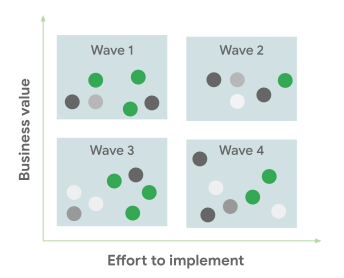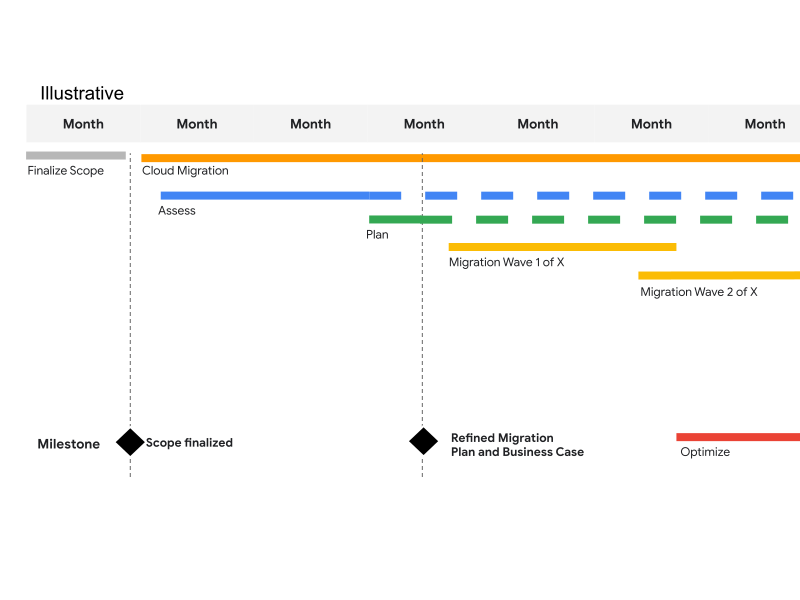This document describes how to plan your migration waves.
You can group migration candidates into migration waves. Grouping can be done at a high-level (category-based) or detailed-level (applications, locations, components), based on the information you collect during the discovery and assessment phase.
Create an application catalog
To start your planning, create an application catalog. Organize your applications into categories based on application architecture, business considerations, and IT operations. This helps prioritize them according to business criticality, complexity and risks involved in moving to the cloud. The combination and prioritization of these factors vary across organizations, their business imperatives, and the mapping of these imperatives to workloads, both in their current architecture, and the future Google Cloud architecture.
The following list presents the three main categories and the factors that you need to consider within each category.
Application architecture
- Technical constraints
- Number of dependencies
- Number of tiers
- Stateful vs stateless
- Performance requirements
- Geographic dependencies
Business considerations
- Compliance requirements
- Business criticality
- Business change capability
- Number of users
- Type of users (internal, external)
- TCO
IT operations
- Operating environment
- Service level agreement
- Availability
- Backup

Map and prioritize
From the application catalog, map out applications based on the complexity and target migration approach. Your migration approach should be based on the business outcomes you expect, the migration effort, and the associated risk factors, both during and after migration.
Then, rank migration candidates in order of priority, based on business value and the effort required to migrate. To prepare for your migration, identify apps with features that make them likely to be moved first. You can pick just one, or include many apps in your first wave. The apps in the first wave let your teams test the deployment in the cloud environment, while focusing on the migration instead of on the complexity of the apps.
Starting with a standalone app lowers your initial risk because later you can apply your team's new knowledge to applications that are more complex and have many dependencies.
Apps in the first wave typically are not business critical and have fewer system and network-to-network dependencies. They also require less refactoring, usually have less data gravity, don't have specific compliance challenges, and can afford a cutover window. For more details, see how to choose the apps to migrate first.

Group applications in waves
Group applications into multiple waves with timelines associated with each wave, along with the time to revise plans based on the feedback from each wave.
- Wave 1: High business value, low effort to implement.
- These applications are ideal candidates for early migrations or proof-of-concepts.
- Wave 2: High business value, high effort to implement.
- These applications may be prioritized next.
- Wave 3: Low business value, low effort to implement.
- These applications may be prioritized next.
- Wave 4: Low business value, high effort to implement.
- These applications should be prioritized last.

After you have defined your migration waves, you can organize them in a project plan.

Follow the best practices
To improve your migration plan, follow the best practices to validate a migration plan. Following the concepts in that document does not give any guarantees for success. However, the document highlights some points that are often overlooked when planning migrations, such as:
- Ensuring that you have a rollback strategy for each step of the migration plan.
- Planning for gradual rollout and deployments, as discussed earlier in this document.
- Alerting all the development and operations teams that are responsible for the workloads to migrate.
- Removing proof-of-concept resources and experiments from the target production environment.
- Defining criteria to safely retire the source environment.
- Ensuring that you conduct a migration risk assessment for each migration wave and execute mitigations for the risks identified.
What's next
- Learn how to execute a migration.
